Bed-Yoga = Asana's you can do in bed as you wake up.
Viewing entries in
NL
Bed-Yoga = Asana's you can do in bed as you wake up.
Bed-Yoga = Asana's you can do in bed to have a better sleep.
I teach yogaflow classes with the wheel, using it as a prop, to massage your body, to relax, to restore, to open the front and the side body, to assist in inversions and to shape up your core.
Having a yogawheel at home is also amazing, to massage your spine or to open shoulders and chest.
*The yoga wheel will immediately stretch your entire front & side body, hip flexors, abdomen, chest, and shoulders. It’s a serious heart opener!
*It will massage the entire length of your spine in a safe (it gives a lot of support) but deep way.
*The wheel helps yoga practitioners move deeper into postures, specifically heart opening postures like backbends and forearm balances.
* The magic wheel will give you the best support in deep backbends. A backbent will not be scary anymore.
*You can also use the wheel to access deeper variations of backbends in poses like forearm balance or Pincha Mayurasana -> my favorite asana. Thanks to the BIG support from the yogawheel you will feel safer and you will have much more balance.
Note => This is an advanced posture that should be practiced with caution and experience – please be safe!
*Aside from the stretching and heart opening aspects, the wheel can also double as a flexibility tool. Let's "roll" yourself deeper in your stretches (breathing & moving slowly).
*Because you always need to look for balance, you can use the wheel to strengthen your core. There are a lot of funny ways to make that core stronger, using the wheel!
*And lastly, the yoga wheel can help challenge and strengthen your balance.
Note => It is not easy so please try with care! :-)
000 HAVE FUN OOO :-)

Yin Yang Yogawheel Workshop at Bocadero.

DEEPER VERSION OF THE CAMEL POSE.

RELAXED VERSION OF A LOVELY HEARTOPENER.

SIDE PLANK => TRY TO LIFT ON LEG & GIVE THE SIDES OF YOUR LEGS A YOGAWHEEL-MASSAGE.

I LOVE THIS ONE :-) ... WATCH YOUR CHIN!!!

LOOK AT MY SUPER DAD!!! HE REALLY ROCKS!!!

HOW BEAUTIFUL CAN A GROUP OF YOGI'S BE! :-)

In simple terms Ujjayi breath is a 'breath regulating technique where the inhale and exhale are the same’. Below are the Sanskrit terms key to Ujjayi breathing:
From our very first breath until our final exhale we are, without any deliberate effort, continuously breathed by our Autonomic Nervous system (ANS). Unlike other ANS actions in the body (like pupil dilation) we are able to take voluntary control over our breathing and thus, critically, can influence our Sympathetic and Parasympathetic Nervous system.
When we breathe Ujjayi breath we transform the automatic into the deliberate and thereby become the master of our internal landscape; we can positively affect how we feel by regulating the length, air volume and sound of our inhales and exhales.
Ujjayi Pranayama is another tool to add to our box, another practice which encourages the mind to rest its awareness on the present moment, and identify with our immediate experience.
Yoga is a practice of integration and deliberate identification. Ujjayi Pranayama is another tool to add to our box, another practice which encourages the mind to rest its awareness on the present moment, and identify with our immediate experience. This process of mindfulness can be one of our biggest conquests. Mastery of the conscious mind. We become absorbed as we synchronise our movement with our breath. Our level of agitation settles, the fluctuations of our mind (chitta vritti) decelerate and for glimpses of a moment we are 'all in'. As we learn to regulate the gross body through different yogic practices including pranayama, we can access and influence our subtle bodies.
Many of us never learned Ujjayi breath formally before rocking up to class, rolling out our mats and being instructed to use the breath throughout our practice. We heard fellow students around us making a funny noise and felt slightly awkward when trying to copy them, feeling sure that we would get it wrong, which would expose us as newbies and imposters – oh the shame!
It is not uncommon to feel self-conscious when first making sound with breath, and then you pluck up the courage to try and a big snorting sound comes out. Like all things Yoga it takes practice and a relinquishment of self-identified inhibition - which also takes practice!
Like all things Yoga, Ujjayi breath takes practice and a relinquishment of self-identified inhibition (which also takes practice!)...but it's a key that unlocks many doors and can transform your practice.
With Ujjayi breath you breathe in and out of the nose with the lips sealed - no breath passes the lips. This also serves to build heat in the body. The lips gently close and although the breath is passing through the nostrils the emphasis is in your throat.
You create a constriction in the throat as if breathing in and out of a thin straw. Whilst maintaining a closed mouth position be mindful of held tension in the teeth, jaw, throat and/or neck – let it go. You can feel the breath stroke the back of your throat as you inhale and exhale. This comes hand in hand with the audibility of the breath, compared often to the sound of waves, Darth Vader and my husband in deep sleep. The tone, the audibility is smooth and steady, continuous uninterrupted cycles of inhales and exhales, often you cannot tell the difference in sound between the exchange of in and out breath cycles.
Along with the even tone of breath, the length of the breath is the same on the inhale as it is on the exhale. You complete a full in-breath within the same time as you complete your out-breath. Using a metronome is a brilliant practice, if you are a musician you might have one already but if not there are some great online/phone applications that I've used with my students before. Set your metronome at 75 bpm, inhale for 4 beats, exhale for 4. An app that accents/ punctuates the beginning of each new cycle of breath is preferable.
With an even tone and length of breath, the last refinement is to breathe fully, deeply and completely (air volume of breath). Within each cycle you spend the entire inhale filling up and entire exhale releasing breath – at no point do you hold the breath - seamless and smooth, try not let the breath run out.
I tend to instruct students who are beginners to breathe with their mouths open to get used to the physical sensation at their throats and sound of breath.
You can practice Ujjayi breath any time you wish. You don't have to be on your yoga mat. But if you are on your yoga mat, acknowledge that the breath creates heat in the body. If you are doing a Yin or Restorative yoga class you may not want to add this element of heat in the body. Instead you might want to maintain a soft and fluid breath without sound. There also might be times in your practice where adding heat is inappropriate (e.g some pregnant practitioners find Ujjayi breath too heating to maintain for an entire practice) or where breathing in and out of the nose is impossible (e.g. blocked sinuses). At times like this you might want to keep the intention of Ujjayi breath in mind without practicing it.
When you own your breath, nobody can steal your peace – Anonymous
FACT - you cannot hyperventilate or even cry and breathe Ujjayi breath at the same time.
https://youtu.be/oRb56apRa40
Watch the youtube intro from Kino => I think she is the best yogini in the world! :-)
Pic => @Ifimmers
- Twists rotate the spine and stretch the muscles of the back. We restore the spine and retain the spine’s natural range of motion. We keep the joints flexible. In a twist, the muscles are extending to their full length and so we prevent the soft tissue to become short and dysfunctional.
- In a twist we create space between the vertebrae so we lengthen the spine and get space between the bones. Our energy can flow better.
- Twist are neutralizing poses so they are good to do after or between strong heart openers or forward bends.
- Twist are working in the center of the body: the abdominal, the obliques, the muscles that support the movement of our spine, and the pelvis.
- Twists aids digestion. In a twist we give a massage to the organs so they create movement in and around the organs.
- In seated twists: ground through the sitting bones.
- Make shure your back is straight. -> Use a block if your spine is rounding.
- Twist from the lower spine up=> the lumbar part rotates 5 degrees, the toracic spine rotates 35 degrees and the cervical spine rotates around 50 degrees.
NOTE= Not one person is the same, so the mobility will be different for every single body.
NOTE= To avoid the neck doing all the work, involve the whole spine by starting the twist from the lower spine - working up – with the neck turning last.
Twists are taught in different ways, with some teachers/styles saying the hips should stay completely level or the sitting bones completely fixed to the floor as you twist. This makes for a deeper twist in the areas of the spine which are able to move. To do this more safely you need to really draw the thighbones back into the hip sockets (not just engage the quads but make it a whole leg movement).
Other teachers say that it is easier on the SI joint to let the opposite hip lift slightly, this is a more natural movement for the body.
Pregnancy - If you’re pregnant some twists should be skipped because of the pressure they place on the abdominal cavity. For example Twisted Triangle or Revolved Side Angle Pose. Gentle open twists like Parivritta Janu Sirsasana are ok after the first trimester.
Source => EkhartYoga Yoga online
Open your heart, your body and your soul.
I really love to open my chest! Heart openers in yoga give me more energy and i feel it all over my body. Opening your body makes you happy. BUT you really have to think about many things to do them in a wright, smooth, save and worthwhile way.
Chest opening yoga poses certainly can help you reverse the mechanical constriction that can overcome the skeleton.
Because we make the spine bend in another way than what we do all day, chest openers are very difficult for most of us. But it is not only about the posture!!! -> If your chest is caving in, your heart and mind are probably going on along with it.
-> Improve Your Posture and Your Attitude Will Follow :-)
In daily, modern life, we spend long ours at the computer, in the office, in the car or at the table.
=> Because of that, the chest is drawing in on itself, the shoulders are rounding forward, we have a turtle neck and the upper body is “hanging down”.
=> Specifically, the pectoralis minor muscles (upper part of the chest), that underlie the bigger pec muscles scrunch up while your upper back muscles -- especially the serratus anterior -- become weak. This muscle imbalance can cause chest pain and restrict your range of motion. Throw a frozen rib cage into the mix and you have a recipe for oxygen depletion, thanks to the fact that drawing a full breath can make the intercostals that connect the ribs feel a bit touchy.
=> All that upper body tension is the gift that keeps on giving and next thing you know the pain is travelling all the way down your spine into your lower back.
=> Chest openers can help reverse that process. J
=> Emotionally, chestopeners are good for releasing sadness, grief, anger and frustration.

I love the "lord of the dance pose" or "Natarajasana", my version of it. I feel it all over my body. It's a beautiful marriage of strength, balance, flexibility, meditation and focus.
Source = http://www.livestrong.com/article/334793-what-are-the-benefits-of-yoga-chest-openers/

How lovely is it to open your chest, making yourself happy, rebalance your body and cleaning your mind, just relaxing and "hanging" out on bolsters and blankets.
-> Mat, strap, mat towel and blocks @Manduka.
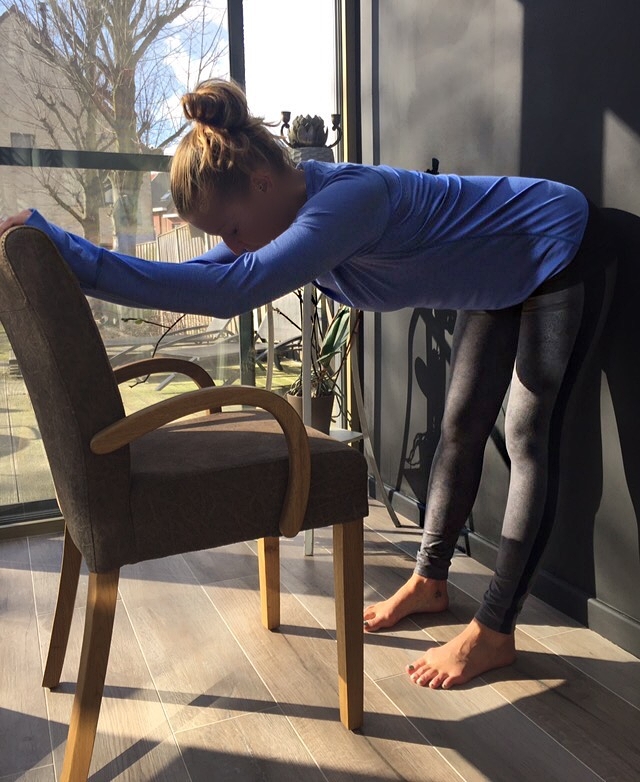
Tips & tricks to make your hamstrings happy.
note -> The bolsters and the blanket are from @Manduka (there is a link on my website).
1 -> Loosen up your back & your hips first & slow down your breath.
2 -> Make shure you go in & out your stretch very slowly and "feel" what you are doing. Do not "push" yourself in a stretch but try to relax your muscles when you go into it. Breath slowly when you hold the stretch for a few breaths.
3 -> Make sure you are bending forward (-> Utthanasana) from the hip -> If you have trouble moving forward in straight legs & if you feel your back is rounding directly when you try to fold => Please bend your legs a little and focus on maintaining a flat or slightly arched back and keeping the chest up when you are folding forward.
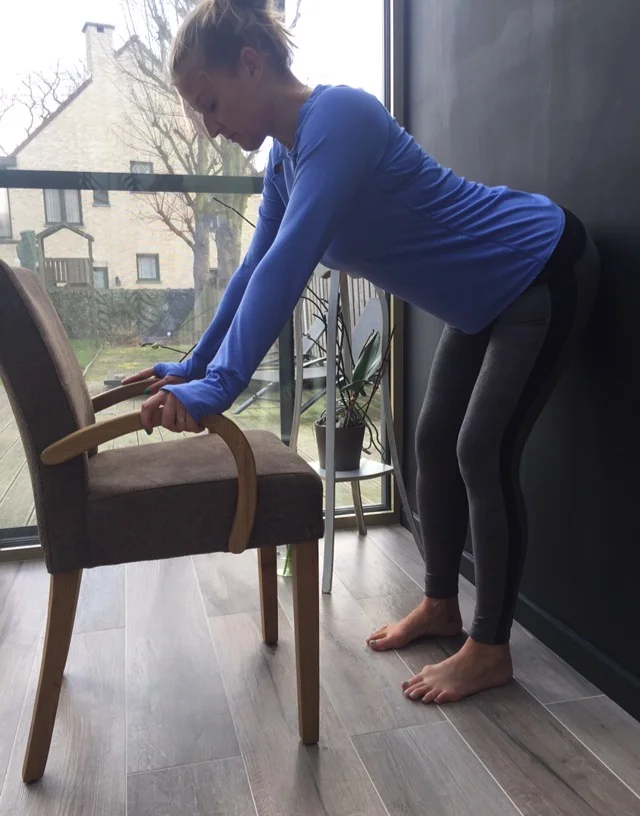
Push your seat bones against the wall & bend your legs for a forward bend with a straight (or slightly arched) back
-> So you bend from the hip and not rounding the back.
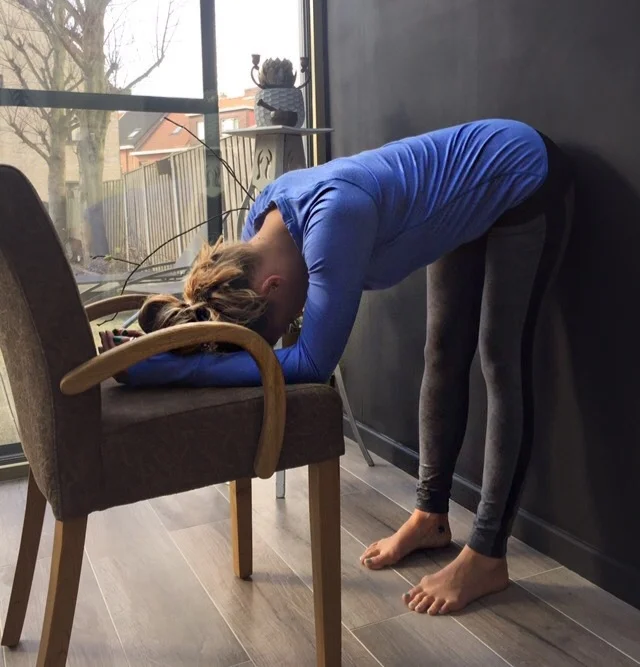
A -> Push your seat bones against the wall, keep your back straight, support your upper body.

B -> Maybe you need to straighten your arms to keep your back straight.

C -> Maybe you need to put your hands higher to keep your back straight.

D -> Or maybe you can bend from the hip, pushing the seat bones against the wall and resting your hands on the floor.
These are some amazing benefits of the Uttanasana.
1. This asana gives your back, hips, calves, and hamstrings a good stretch.
2. It calms your mind and relieves anxiety. It also helps to quiet your mind.
3. It helps relieve headaches and insomnia.
4. This bend gives your digestive organs a good massage and improves digestion.
5. The kidneys and liver are activated.
6. The thighs and knees become strong.
7. Menopause and menstrual problems are alleviated.
8. This asana helps to cure high blood pressure , asthma, infertility, sinusitis, and osteoporosis.

Restorative A -> Hamstring-stretch -> support your upper body with a bolster.
Stay 3 minutes. -> Make sure you are totally relaxed in the pose!

Restorative B -> Maybe you need to level up your seat bones, to be able to bend forward from the hip
-> So you also level up the bolsters. -> Stay 3 minutes.
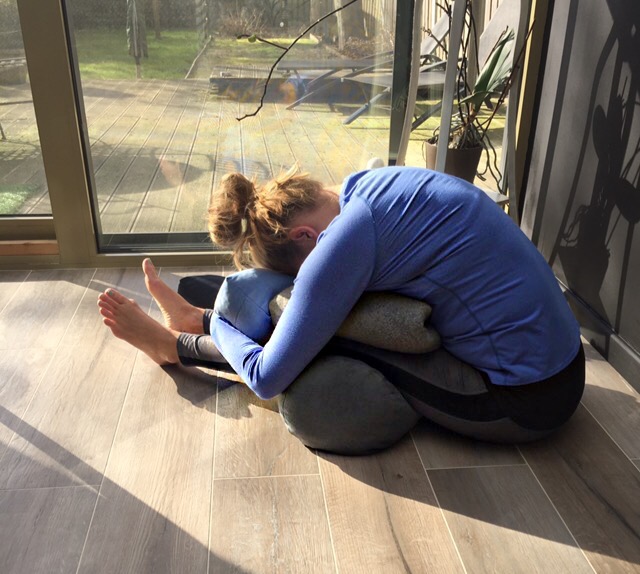
Restorative C -> If it is really difficult to bend from the hip, it is an option to bend your knees
-> so put a bolster under the knees and do the forward bend from here.
Note -> Going a few steps back for some weeks to feel new things in your stretch!!!!
Do you suffer from pain between your shoulder blades and tightness in your upper back and neck? We all suffer from "wrong" positions like working behind a desk, driving a car or sitting too long in the same position.
My video shows a little trick/restorative asana to release the tension in the upper back. Please try to stay at least 5 minutes in this relaxing pose, repeating this ones every day. :-)
-> Make sure the bottle is empty :-) and close the bottle. Lay down on your back with your feet on the floor and your knees up. Put the bottle between the shoulder blades (make sure your neck is not touching the bottle. -> Take your time to make sure you are relaxed in the pose.
-> Breath slowly. When a thought pops up, recognize it, let it go & bring your attention back to the breath to clear your mind.
-> This asana also relaxes your iliopsoas or hip flexor. The iliopsoas is important for standing, walking and running. The hip flexor is responsible for lifting the upper leg to the torso or flexing the torso towards the thighs. By doing this pose we relax the hip flexors.

A= Grab a shawl in your R hand, R arm in the air, bend your arm & bring him as close as you can to your ear, grab the shawl on the other side with your L hand -> take your time & grab the shawl as close as you can to your R hand=> R elbow as high as you can in the air, your L elbow as close as you can to your waist. Slow breaths.

A/2 = Hold the previous stretch, ground your seat bones, bend to the L -> keep your breath slow!

A/3 = Same stretch, bend to the R.

A/4 = L arm is up. If one side is more difficult -> Give it more love! :-)

A/5 = L arm up, ground seat bones, bend to the R.

A/6 = L arm up, bend to the L.

B = Ground your seat bones, stretch to the L, breath space in your R side.

B/2 = Same stretch to the R, breath space in your left side.

C = Cross your fingers, straighten your arms, keep the shoulders low, push your palms to the sky.
C/2 = Same same but cross your fingers the weird way.
note = I over-stretch my arms-> just straight is better! ;-)

C/3 = Same stretch, ground your seat bones, bend to the L & to the R.

D = Both feet on your desk, bend forward -> (Paschimottanasana) calms the brain, stretches the spine, shoulders & hamstrings, stimulates liver & kidneys and improves digestion.

D/2 = Maybe bend your legs a little or put only one foot on your desk -> Maybe only do this one when you are alone in the office :-)
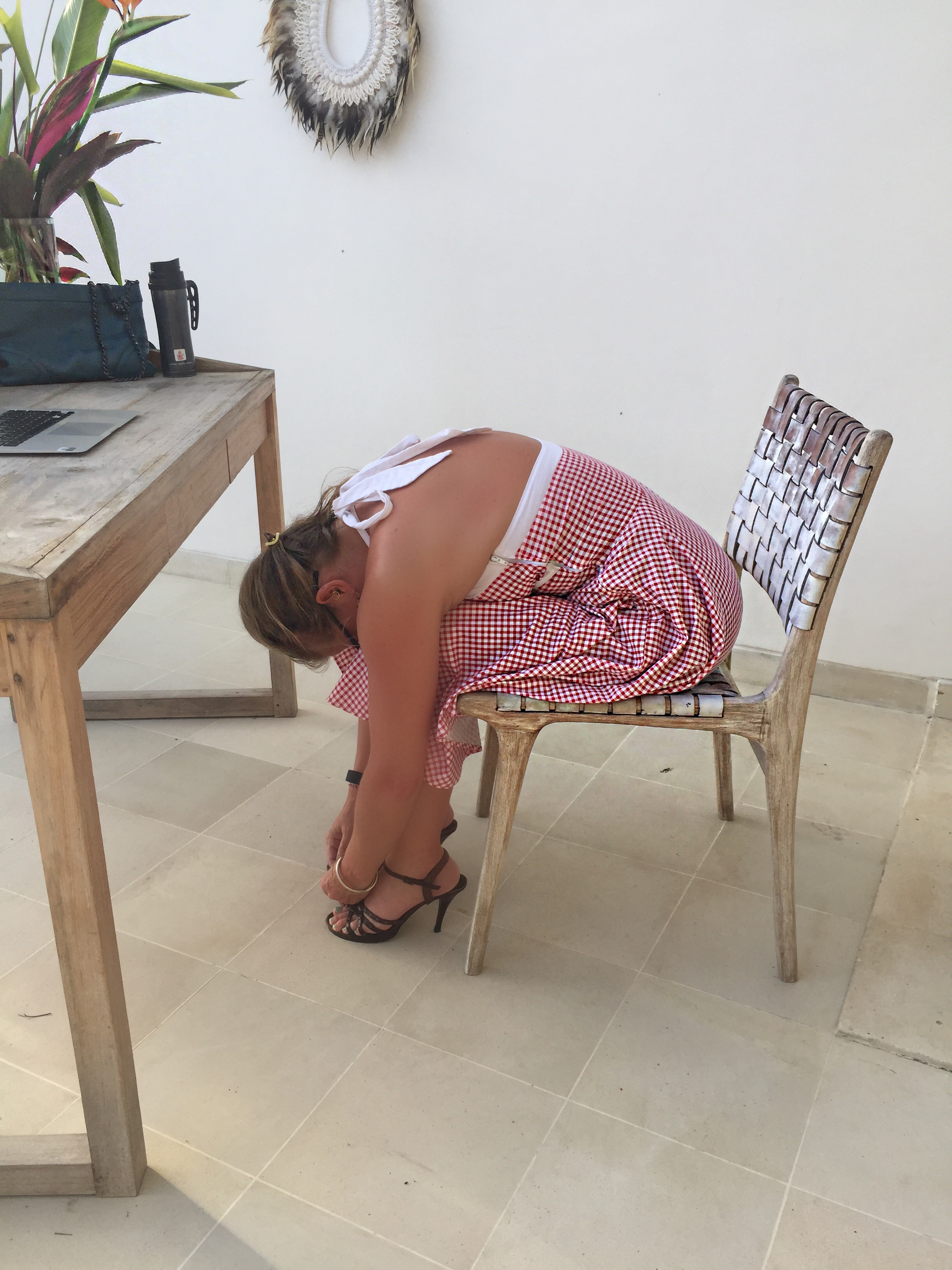
E = Ground your feet in the floor, bend forward, breath slowly -> calms the brain, stretches the spine, relaxes the shoulders, stimulates liver & kidneys and improves digestion.

F = note -> Only when you are alone at the office :-).
Straighten your legs & your arms, relax your head, keep your legs active, relax your belly, breath slowly, do not push or work hard in this pose but relax in it-> so do not go to deep.

F/2 = note -> Only when you are alone in the office :-).
Same as F, if you can -> try to go dieper.

G = Put one foot on your desk, straighten both legs, keep your back straight, relax the shoulders, bring your upper body to your desk. -> Your hamstrings will love you!!!
-> Stretch BOTH legs & give more love to the side which is more difficult.

G/2 = If your desk is to high or your hamstrings not happy :-/ -> put on foot on a chair. -> Stretch BOTH legs & give more love to the side which is more difficult.
Do you know you can do yoga at your desk? Even the smallest exercises will make a difference in your day. A few "asana's" a day can help you to change your posture, your energy level and your state of mind. Look at my pics, try and feel what they can do for you.





Hips: flex your foot to protect your knee


stretch your neck: keep your back straight, put one hand under your bum to keep your shoulder low.





Note-> Attention!!! When you have an office chair on wheels: MAKE SHURE the weeks are blocked! :-)

Note-> Attention!!! When you have an office chair on wheels: MAKE SHURE the weeks are blocked! :-)
